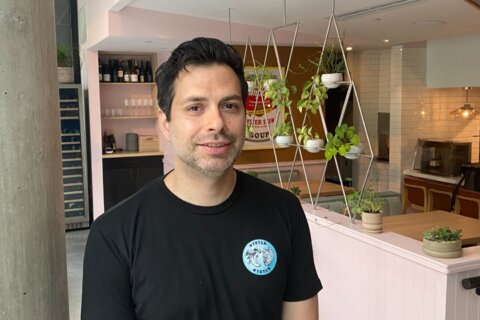Lindsay Tupper used to subscribe to the belief that low fat was good, and no fat was even better. Once, as a college student trying to reverse the freshman 15, she bought a giant tub of red licorice. It was fat-free, after all.
“I thought, ‘If I don’t eat fat, I won’t get fat,'” says Tupper, a 33-year-old mom and photographer in Houston. “That did not work at all.”
Soon after, when she returned to her hometown to care for her mom who had suffered a brain aneurysm, Tapper became more health-savvy. “Trying to get her better and healthier, I found nutrition to be very important,” says Tupper, who was also dealing with heartburn and skin problems.
After reading “The China Study,” a book that links animal products to chronic diseases, she became a vegetarian. But after a couple years, she wasn’t seeing results. Plus, the more she read, the more she learned she should be supplementing with vitamins.
“I was like, ‘That doesn’t make any sense to me. If it’s so healthy, why can’t you get everything your body needs?” Tupper remembers. “I started eating meat again.” Today, she follows a “primal” diet, which, like the paleo diet, emphasizes meat and plants and snubs grains. “I definitely feel like it’s improved my health a lot.” says Tupper, now a nutrition consultant who launched the blog Paleo Fitness Mama.
Vegetarians-turned-paleo eaters like Tupper are everywhere, despite the diets’ apparent contradictions. Anne Hathaway and Bill Clinton reportedly made the shift, while nutrition experts (and U.S. News bloggers) Alexandra Jamieson and Keri Gans are also former vegetarians who now enjoy meat regularly. Even David Soto Jr., author of “The Complete Guide to Primitive Eating” and blogger at The Primitive You, is a former vegetarian. “A lot of people don’t know that about me,” he says.
That’s not to say vegetarianism is going anywhere — nor should it, experts stress. After all, the latest iteration of the Dietary Guidelines for Americans, expected to be released later this year by the U.S. Department of Health and Human Services and the U.S. Department of Agriculture, touts fruits, vegetables and grains, and looks down on meats — especially red and processed kinds.
“There’s lots of research showing that people who do vegetarian diets well have a much lower risk for just about everything,” says Elizabeth Somer, a registered dietitian in Salem, Oregon. Here’s what she and other experts say you should know before trading a meat-free diet for a meat-laden one — or vice versa:
1. Ask yourself why.
When someone goes from one diet to another, it’s usually for one of two reasons, says Brian Wansink, a marketing professor at Cornell University, where he directs the Cornell Food and Brand Lab. Either the person subscribes to a “food as medicine” way of thinking and the first diet isn’t treating what ails them, or the person went on the first diet to achieve some goal like weight loss — and met it.
“Either it doesn’t work and you say, ‘The heck with it!’ Or, it does work and you say, ‘I don’t need it any longer,'” says Wansink, one of 22 expert panelists who help U.S. News produce its annual Best Diets rankings.
But jumping from one diet to the next in search of a quick fix for, say, an expanding waistline or upcoming wedding, is likely to do more harm than good, Somer says. “In the long run, as you get either bored with [the diet] or lazy … typically, the weight comes right back,” she says. “Take a really hard look at why you’re making the change in the first place.”
2. Take it slow.
When Soto decided to add meat back into his diet after four years of abstinence, he did it the only way he knew how: “I went out and said let’s get the biggest steak I can find,” he says. “I just got a steak and I ate the whole thing — and I never went back.”
While Soto says his go-big-or-go-home approach didn’t cause any problems, that method is risky since longtime vegetarians’ bodies stop making as many enzymes to break down meat, Somer says. “So you start chowing down on a 12-ounce T-bone, and you’re either going to have some serious GI-tract diarrhea or constipation for a while until your body catches up and starts making the enzymes it needs.”
On the other hand, if someone who skimped on fiber on a meat-heavy diet begins suddenly eating a fiber-rich vegan or vegetarian diet, “the tsunami of fiber … could present a bit of a problem with gas and GI tract discomfort for a few weeks,” Somer says.
That’s one reason why it’s helpful to make small changes to your diet rather than making a drastic shift overnight. Another reason to take it slowly? To boost your odds of long-term success, Somer says. “You’re much more likely to stick to a diet if you gradually tweak the one you’re already on rather than leaping from one tight barge to the next.”
3. Do it right.
Cutting meat from your diet may make you a vegetarian, but that alone won’t make you healthy, Somer says. “I seldom see someone do vegetarian right,” she says. “They’re still eating white bread, they’re still eating Pop-Tarts. There’s a whole lot of crap in those grocery store shelves that is vegetarian, but we would be far better off if they had never been developed in the first place.”
Likewise, people who switch to the paleo diet aren’t going to experience health benefits if they forgo vegetables in favor of bacon three times a day, says Nancy Kennedy, a fitness and nutrition expert in Los Angeles who wrote “The Hollywood Wrap.” Kennedy used to be vegetarian but now eats paleo about 85 percent of the time. She recommends taking a similarly moderate approach to any diet. “Life is short,” she says. “We just can’t do this every day, all day.”
There’s also lots of room for error when it comes to the balance of nutrients in a new diet. Vegans, for example, often lack vitamins D, B12, B6 and omega-3 fatty acids, while paleo dieters often don’t get enough vitamins D and E, Somer says. “The more you limit your food choices, the higher your risk of being deficient,” she says.
That’s why it’s key to call in a nutrition professional, say a registered dietitian, who can help identify gaps in your diet if you’re planning to make a significant change, Somer says. “Unless you’ve done the research and [got] it form a credible source, it’s very likely, in our toxic food environment, to end up eating poorly,” she says.
Seeing someone with formal training, she adds, will better ensure you’re “not doing more harm than good.”
More from U.S. News
7 Reasons to Choose a Plant-Based Diet
Easiest Diets to Follow: in Pictures
How to Have a Paleo Thanksgiving
When Vegetarians Go Paleo originally appeared on usnews.com







